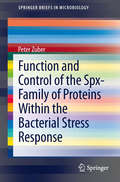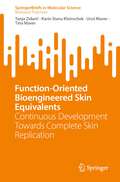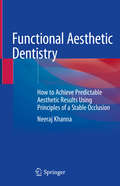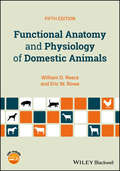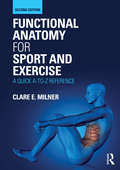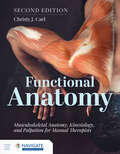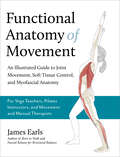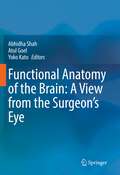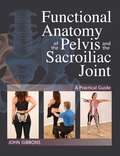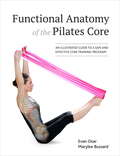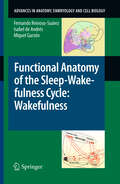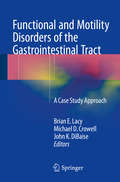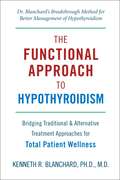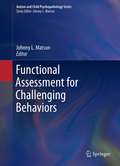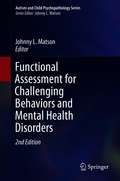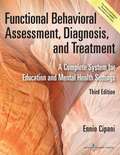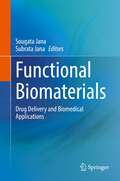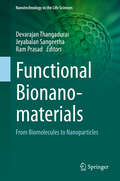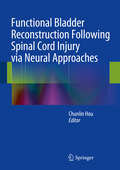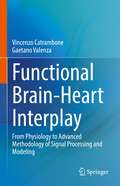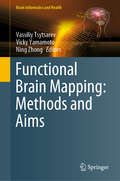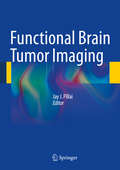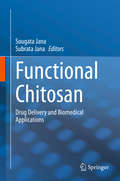- Table View
- List View
Function and Control of the Spx-Family of Proteins Within the Bacterial Stress Response
by Peter ZuberThis SpringerBrief on Spx reviews the investigations that led to the discovery of Spx and its orthologs and ties together the results of various studies that have explored the function and control of spx in Gram-positive organisms. Spx of Bacillus subtilis has been extensively studied, but very little has been published about it. This book incorporates a number of studies that have been conducted in other Gram positive bacteria, which examined the role of Spx orthologs in stress response, bacterial development and virulence. The book contains an overview that will introduce the protein and its orthologous forms, its association with RNA polymerase, the species of Gram-positive bacteria in which it is found, and the conditions in which it is abundant and active. Spx is a member of a large group of proteins belonging to the ArsC/Spx protein family, so the review touches upon the bioinformatic support for the protein family composition and its meaning with regard to protein structure/function.
Function-Oriented Bioengineered Skin Equivalents: Continuous Development Towards Complete Skin Replication (SpringerBriefs in Molecular Science)
by Tanja Zidarič Karin Stana Kleinschek Uroš Maver Tina MaverThe book Function-oriented bioengineered skin equivalents - continuous development towards complete skin replication aims to provide potential readers with a comprehensive summary of the available information on various in vitro skin models, from historical background to different modeling approaches and their applications. Particular emphasis is placed on presenting the current technological components available for the development of engineered skin equivalents by summarizing advances in cell cultivation, materials science, and bioengineering. Using examples of the current-state-of-art, we describe the advantages, limitations, and challenges of developing in vitro skin models for successful use in clinical applications and skin-related research.
Functional Aesthetic Dentistry: How to Achieve Predictable Aesthetic Results Using Principles of a Stable Occlusion
by Neeraj KhannaThis book provides all the information needed by the dentist in order to understand functional occlusion and describes a coherent method that, through application of principles of form and function, allows the delivery of predictable, natural, and long-lasting aesthetic results. After clear explanation of the concepts of functional aesthetics, functional occlusion, and the envelope of function, the 12 stages of a complete examination are carefully set out, with accompanying rationale. Similarly, full guidance is provided on acquisition of appropriate diagnostic records, comprising perfect impressions, facebow transfer, centric relation bite record, and digital photographs. Further, a method for correct determination of the incisal edge position is presented, with explanation of the importance of this position to aesthetics, function, and phonetics. A step-by-step description of the treatment planning process is then provided, followed by guidance on preparation design and fabrication of restorations. Readers will find the book to be an invaluable aid to attainment of consistent aesthetic results based on stable occlusion.
Functional Anatomy and Physiology of Domestic Animals
by William O. ReeceFunctional Anatomy and Physiology of Domestic Animals, Fourth Edition provides a thorough grounding in the structure and function of animal body systems. Taking an integrated approach to the basics of anatomy and physiology, the book helps readers understand their interconnection in common domestic species. With chapters logically arranged by system, Functional Anatomy and Physiology of Domestic Animals offers students in pre-veterinary or veterinary technology programs an excellent introduction to body systems and acts as a quick review of the basics for more advanced courses or in the clinical setting.
Functional Anatomy and Physiology of Domestic Animals
by William O. Reece Eric W. RoweNow in its Fifth Edition, Functional Anatomy and Physiology of Domestic Animals provides a basic understanding of domestic animal anatomy and physiology, taking an interconnected approach to structure and function of the horse, dog, cat, cow, sheep, goat, pig, and chicken. Offers a readable introduction to basic knowledge in domestic animal anatomy and physiology Covers equine, canine, feline, bovine, ovine, ruminant, swine, and poultry anatomy and physiology Considers structure and function in relation to each other for a full understanding of the relationship between the two Provides pedagogical tools to promote learning, including chapter outlines, study questions, self-evaluation exercises, clinical correlates, key terms, suggested readings, and a robust art program Includes access to a companion website with video clips, review questions, and the figures from the book in PowerPoint
Functional Anatomy for Sport and Exercise: A Quick A-to-Z Reference
by Clare E. MilnerFunctional Anatomy for Sport and Exercise: A Quick A-to-Z Reference is the most user-friendly and accessible available reference to human musculoskeletal anatomy in its moving, active context. Fully updated and revised, the second edition features more illustrations to enhance student learning and an expanded hot topics section to highlight key areas of research in sport and exercise. An accessible format makes it easy for students to locate clear, concise explanations and descriptions of anatomical structures, human movement terms and key concepts. Covering all major anatomical areas, the book includes: an A-to-Z guide to anatomical terms and concepts, from the head to the foot clear and detailed colour illustrations cross-referenced entries throughout hot topics discussed in more detail in sports examples discussed in more detail full references and suggested further reading This book is an essential quick reference for undergraduate students in applied anatomy, functional anatomy, kinesiology, sport and exercise science, physical education, strength and conditioning, biomechanics and athletic training.
Functional Anatomy: Musculoskeletal Anatomy, Kinesiology, and Palpation for Manual Therapists
by Christy CaelWith the use of dynamic visuals and kinesthetic exercises, Functional Anatomy, Second Edition helps readers to explore and understand the body's structures, regions, layer of the body, from bones to ligaments to superficial and deep muscles. Muscle profiles indicate origin, insertion, and innervation points while step-by-step instructions teach effective bone and muscle palpation. Readers will also learn how structures help the body move through joint motion, and passive and resisted range of motion techniques. Each region ends with the culmination of structure and function to illustrate how they function together to achieve motion of daily activities as well as the movement involved in sports. Every new print copy includes Navigate Advantage Access that unlocks a complete, interactive eBook, writable PDF Workbook, videos, animations, flashcards, audio glossary, Anatomy & Physiology Review Module, and more!
Functional Anatomy of Movement: An Illustrated Guide to Joint Movement, Soft Tissue Control, and Myofascial Anatomy-- For yoga teachers, pilates instructors & movement & manual therapists
by James EarlsA unique and comprehensive approach to functional anatomy through the lens of myofascial continuities, from the coauthor of Fascial Release for Structural BalanceWhether we describe them as anatomy trains, myofascial chains, meridians, or slings—insights into the interconnected nature of fascial tissue have had a profound impact on our understanding of anatomy.The concept of tensegrity—the idea that changes in tension may affect the whole body rather than just one part—has likewise opened up new appreciations for the complex and interdependent nature of real-world bodily movements. But musculoskeletal anatomy still tends to be taught in a drastically simplified fashion, through the study of fixed anatomical positions that do little to prepare us for the reality of actual movements. In Functional Myofascial Anatomy, James Earls suggests that we need a new set of tools and vocabulary for watching and describing anatomy in motion. Earls argues that it is seeing movement in action—in different bodies and in different environments—that should inform our understanding of anatomy, rather than the other way around.By situating the different theories and metaphors of myofascial continuities against the context of common real-life movements such as sports exercises and yoga asanas, Earls explains how each theoretical system may be useful in different situations and applicable to different issues. Using up-to-date research, Earls digs into important questions for physical and manual therapists: which tissues really are contiguous? Does continuity of tissue actually show or demonstrate transmission of force and communication along those lines? And does fascial tissue have to be continuous for the body to actually transfer force?Accessibly written and fully illustrated, Functional Myofascial Anatomy offers practical applications for physical therapists, chiropractors, and bodyworkers, as well as new tools for teachers of yoga and pilates to develop a deeper understanding of anatomy and movement.
Functional Anatomy of the Brain: A View from the Surgeon’s Eye
by Abhidha Shah Atul Goel Yoko KatoThis book essentially provides a refreshing description of the cortical and subcortical anatomy of the brain and how it relates to function. It includes subtleties of anatomy, advances in imaging, operative nuances, techniques, and a brief discussion about artificial intelligence.It discusses surgical strategies on intrinsic brain tumors in general and gliomas in particular with several images. The issues that need to be considered in decision-making are explained in this book. The best surgical options are described step-by-step. The relevant anatomy and function of the region are discussed and show the consequences of the damage.This book covers the intra-operative nuances to prevent neurological morbidity. Modern imaging features that help during surgery and decision-making are elaborated. The book is heavily illustrated with anatomical images, intraoperative images, radiologic images, and drawings supported by videos of the surgical approaches and techniques.The chapter structure involves reoccurring headings, didactic elements such as chapter summaries, boxes (note, caution), bullet points, tables, flowcharts, key points. This book is handy for neurosurgeons, especially neuro-oncologists, which helps keep them abreast with the advances in the field.
Functional Anatomy of the Pelvis and the Sacroiliac Joint: A Practical Guide
by John GibbonsThis step-by-step guide for assessing the pelvis and sacroiliac joint by respected bodywork specialist John Gibbons explores all aspects of this crucial area of the body and how it links within the kinetic chain system. Gibbons--a registered sports osteopath who specializes in the treatment and rehabilitation of sport-related injuries—provides detailed information about how to recognize pain and dysfunctional patterns that arise from the pelvic girdle along with techniques to identify and correct a number of impaired patterns as well as functional exercises that promote recovery. Fully illustrated with 350 color photos, this book will give practitioners, students, and anyone who wants to understand pelvic pain and what they can do about it a wealth of practical information. Gibbons addresses key issues such as the walking/gait cycle and its relationship to the pelvis; leg length discrepancy and its relationship to the kinetic chain and the pelvis; the laws of spinal mechanics, the relationship of the hip joint, gluteal muscles, and lumbar spine to the pelvis; and sacroiliac joint screening. He discusses role of the Glutes, Psoas, Rectus femoris and other muscles and what happens to the position of the pelvis if these soft tissues become shortened. Detailed exercises and techniques are carefully illustrated with photographs that explain each movement, and an appendix for quick reference adds to the usefulness of the text.
Functional Anatomy of the Pilates Core
by Evan Osar Marylee BussardThis book is the first to illustrate the essential connection between the functional anatomy of the body's core and its application during Pilates' fundamental core exercises. Focusing on the inherent potential of the human body to stabilize and move, Dr. Evan Osar and Marylee Bussard combine the most current research around core stabilization with six fundamental Pilates principles to offer simple, easy-to-use strategies for relieving discomfort and improving pain-free movement. With more than 290 full-color illustrations, Functional Anatomy of the Pilates Core provides both Pilates practitioners and professional teachers with a comprehensive understanding of how the core functions and how stabilization helps promote health and proper movement patterns through the development of balanced muscles, joint alignment, and core control.The authors apply current research on neuroplasticity, the brain's capacity to reorganize itself by developing new neuronal connections, and on the function of fascia, the matrix-like connective tissue of the body, to explain the six fundamental principles of Pilates--Centering, Concentration, Control, Precision, Breath, and Flow. They show how to avoid muscle imbalances, chronic tightness, and pain by incorporating the principles of functional anatomy during exercise. Readers learn how to: * Achieve the alignment, breathing, and control required for developing optimal posture and movement * Alleviate non-optimal habits that relate to common postural dysfunction, muscle imbalances, and chronic tightness * Integrate the fundamental Pilates exercises in order to develop a more stable core and eliminate the risks of common injuries while accomplishing one's health and fitness goalsFrom the Trade Paperback edition.
Functional Anatomy of the Sleep-Wakefulness Cycle: Wakefulness
by Fernando Reinoso-Suárez Miguel Garzón Isabel De AndrésSleep is a necessary, active, diverse and periodic condition, homeostatically regulated and precisely meshed with waking time into the sleep-wakefulness cycle. The authors present a detailed and updated review of the structures involved in the phase of wakefulness, including their morphological, functional and chemical characteristics, as well as their anatomical connections
Functional and Motility Disorders of the Gastrointestinal Tract
by Brian E. Lacy Michael D. Crowell John K. DibaiseThis volume covers the myriad of functional and motility gastrointestinal disorders in a comprehensive manner. The book is divided into seven major sections, with each section beginning with a brief case presentation highlighting the specific disorder to be reviewed. Appropriate criteria is highlighted, followed by a brief review on the epidemiology, etiology, pathophysiology, diagnosis and treatment of each specific disorder. 2-3 key teaching "pearls", test questions and key references are also provided for each chapter. The book is organized so that each chapter can stand on its own and be used as a quick reference source in the clinic. Alternatively, it can be read cover to cover as an authoritative textbook on gastrointestinal functional and motility disorders. Written by international experts in the field of motility disorders, Functional and Motility Disorders of the Gastrointestinal Tract: A Case Study Approach is an invaluable resource for experienced physicians, students, residents, fellows, nurse practitioners and physician assistants.
Functional Approach to Hypothyroidism: Bridging Traditional and Alternative Treatment Approaches for Total Patient Wellness
by Kenneth BlanchardThe first comprehensive book to challenge the traditional teachings by presenting a more effective approach to treating hypothyroidism.For many years, treatment options for hypothyroidism have remained relatively unchanged and new treatments have been unexplored despite the fact that this disorder affects tens of millions of people in the United States. In The Functional Approach to Hypothyroidism, Dr. Kenneth Blanchard uncovers the truth about treatments and diagnoses and offers new insight into reducing symptoms for those with hypothyroidism. Patients and physicians alike will benefit from the wisdom and guidance found in this book.The Functional Approach to Hypothyroidism also includes explanations of:* Why hypothyroidism is often misdiagnosed* Misguided teachings on the treatment of hypothyroidism* Effects of hypothyroidism on pregnancy, menstrual cycle, and fertility* The connection between fibromyalgia and hypothyroidism* The effects of hypothyroidism on weight, sleep, and motion sickness* More effective treatments and advice for proper diagnosisThe Functional Approach to Hypothyroidism is based on the innovative findings of Dr. Kenneth Blanchard, a specialist in thyroid disease and menopausal hormone replacement therapy. Dr. Blanchard has treated over 1,000 patients with hypothyroidism with great success. Through this experience, he has developed a unique approach to the field and has simultaneously enabled patients to better understand their condition, treatments, and the current findings.
Functional Assessment for Challenging Behaviors
by Johnny L. MatsonAs the cornerstone of applied behavior analysis, functional assessment is supported by a burgeoning literature that focuses on identification of and interventions for aggressive, self-injurious, and other challenging behaviors. Although the number of research studies continues to grow, full-length volumes on using functional assessment to address these behaviors remain few and far between. Comprehensive in coverage, Functional Assessment for Challenging Behaviors expands the knowledge base by providing information on all aspects of its topic. This unique volume addresses basic questions in salient detail, from types and rates of challenging behaviors to populations that warrant functional assessment. In addition, it examines typical assessment techniques, including interview, scaling, experimental, and in vivo methods. The use of functional assessment in treatment planning - and in combination with other interventions - is covered in depth. An especially timely chapter identifies key ethical and legal concerns in working with challenging behavior populations. Coverage includes: The history of behavior analysis and functional assessment.The nature, prevalence, and characteristics of challenging behaviors.Interview and observation methods in functional assessment and analysis.Experimental functional analysis for challenging behaviors.Treatment methods commonly used with functional assessment.Using functional assessment in treatment planning. Functional Assessment for Challenging Behaviors is an essential resource for researchers, scientist-practitioners, and graduate students in clinical child and school psychology, pediatric psychiatry and medicine, social work, rehabilitation, and developmental psychology.
Functional Assessment for Challenging Behaviors and Mental Health Disorders (Autism and Child Psychopathology Series)
by Johnny L. MatsonThis Second Edition updates and expands on the original editorial content and coverage, including new chapters on definitions and rationale, a general overview, research on mental health disorders, report writing, the role of treatment planning, and treatment associated with mental health disorders. The Second Edition builds on the knowledge base by providing the most current information on all aspects of each topic. This unique volume addresses basic questions in salient detail, from types and rates of challenging behaviors to populations that warrant functional assessment. In addition, it examines typical assessment techniques, including interview, scaling, experimental, and in vivo methods. The use of functional assessment in treatment planning – and in combination with other interventions – is covered in depth. Given the vulnerable populations and challenging behaviors (e.g., individuals with autism, intellectual disabilities, mental health issues), the book provides detailed coverage of informed consent as well as legal and ethical issues. Key areas of coverage include:The history of behavior analysis and functional assessment.The nature, prevalence, and characteristics of challenging behaviors.Interview and observation methods in functional assessment and analysis.Experimental functional analysis for challenging behaviors.Treatment methods commonly used with functional assessment.Using functional assessment in treatment planning. Functional Assessment for Challenging Behaviors, Second Edition, is an essential updated resource for researchers, clinicians and other practitioners, and graduate students in clinical child and school psychology, pediatric psychiatry and medicine, social work, rehabilitation, developmental psychology as well as other interrelated disciplines.
Functional Assessment in Massage Therapy
by Whitney LoweA guide to orthopedic assessment of pain and injury conditions for the massage practitioner.
Functional Behavioral Assessment, Diagnosis, And Treatment: A Complete System For Education And Mental Health Settings (Third)
by Ennio CipaniFeaturing a highly interactive approach, this text is noted for its exceptionally clear and thorough coverage of how to conduct a functional behavioral assessment (FBA) through various assessment methods, how to diagnose the function of problem behaviors, and how to select a behavioral intervention that addresses the diagnosed function. The development of requisite behavior-analytic skills is aided by utilizing many "real-life" and hypothetical cases that represent common scenarios in applied settings. Highlights include: Interactive approach, icons in the text alert readers to review related narrated online lectures highlighting FBAs and treatments and complete assignments embedded in text. Numerous cases, many based on the author's clinical experiences in working with children and adults in educational and mental health settings, provide a realistic look at applied behavior analysis. Forms, interview protocols, and intervention plans illustrate the process of creating behavior plans from collected assessment data. A pioneering classification system for categorizing the function of problem behavior (Cipani BCS). Cases that model the process of assessment, classification, and treatment used in an FBA allow readers to role-play and develop presentation and classification skills. New to this edition: Chapter objectives and BACB Tasks that match the content to be covered with objectives from the Behavior Analyst Certification Board (BACB) task list help readers master some of the skills required of behavior analysts. Assignments and discussion items with associated narrated PowerPoint lectures to further engage readers. Simulation Exercises to actively involve readers in collecting data, conducting an assessment, demonstrating the use of a function, or observing how to "shape" an alternate behavior. Self-Assessment exercises to help readers test their understanding of the content. The Cipani EO School Behavioral Interview Rating System to help in conducting interviews. The Cipani Replacement Function Classification System for determining the strength of replacement behaviors. Online instructor's resources including test items tied to the chapter objectives, chapter PowerPoints with assignments, a course syllabus builder, and What to Read if You Used the Second Edition (Conversion Guide). Online student resources including narrated PowerPoints and video lectures. An ideal text for courses in (applied) behavior analysis, behavioral or emotional assessment or management, child psychopathology, or developmental disabilities taught in school psychology, special education, behavior analysis, psychology, or social work; anyone who assesses and treats patients with challenging behaviors will also appreciate this book.
Functional Biomaterials: Drug Delivery and Biomedical Applications
by Sougata Jana Subrata JanaThis book explores in depth a wide range of functional biomaterials-based systems for drug, gene delivery, and biomedical aspects. The chapters cover newer technologies such as polymeric micelle, pH-responsive biomaterials, stimuli-responsive hydrogels, silk fibroin, inorganic biomaterials, synthetic biomaterials, 3D printed biomaterials, metallic biomaterials, ceramic and hybrid biomaterials. It also describes the theranostic approaches for cancer therapy, the biomaterials-based nanofibers scaffolds in tissue engineering, as well as the strategies applications of metallic biomaterials for the medical and dental prosthetic field. This newer and updated approach will be attractive for biomedical engineering students working on materials science in the development of novel drug delivery strategies. The book will be an important reference for researchers and professionals working on biomaterial research in the pharmaceutical and medical fields.
Functional Bionanomaterials: From Biomolecules to Nanoparticles (Nanotechnology in the Life Sciences)
by Devarajan Thangadurai Jeyabalan Sangeetha Ram PrasadThis book focuses on the application of nanotechnology in medicine and drug delivery, including diagnosis and therapy. Nanomedicine can contribute to the development of a personalized medicine both for diagnosis and therapy. By interacting with biological molecules at nanoscale level, nanotechnology opens up an immense field of research and applications. Interactions between artificial molecular assemblies or nanodevices and biomolecules can be understood both in the extracellular medium and inside human cells. Operating at nanoscale allows exploitation of physical properties different from those observed at microscale, such as the volume to surface area ratio.A number of clinical applications of nanobiotechnology, such as disease diagnosis, target-specific drug delivery, and molecular imaging are being investigated. Some promising new products are also undergoing clinical trials. Such advanced applications of this approach to biological systems will undoubtedly transform the foundations of diagnosis, treatment, and prevention of disease in the future.Nanomedicine sales reached $16 billion in 2015, with a minimum of $3.8 billion in nanotechnology R&D being invested each year. Global funding for emerging nanotechnology increased by 45% per year in recent years, with product sales exceeding $1 trillion in 2013. As the nanomedicine industry continues to grow, it is expected to have a significant impact on the global economy.This book provides clear, colorful and simple illustrations, tables, and case studies to clearly convey the content to a general audience and reader. This book also discusses the development of nanobiomaterials from biogenic (biological sources) systems for healthcare and disease therapies. This book, therefore, is useful for researchers and academicians in the fields of nanotechnology, medicine, nano-biotechnology and pharmacology.
Functional Bladder Reconstruction Following Spinal Cord Injury via Neural Approaches
by Chunlin HouOne of the most common problems for spinal cord injury patients is urinary system dysfunction. The book Functional Bladder Reconstruction Following Spinal Cord Injury via Neural Approaches introduces how to solve this problem using multi-disciplinary approaches. From animal model studies to surgical techniques as well as successful case reports, six kinds of surgery are presented in separate chapters. This up-to-date monograph will be a valuable resource for surgeons, urologists and neurologists caring for spinal cord injury patients. The contributors are a group of surgeons working in the fields of orthopaedics and microsurgery. Editor Chunlin Hou is Professor in Changzheng Hospital, the Second Military Medical University, Shanghai, China.
Functional Brain-Heart Interplay: From Physiology to Advanced Methodology of Signal Processing and Modeling
by Vincenzo Catrambone Gaetano ValenzaThis monograph offers a cross-system exchange and cross-modality investigation into brain-heart interplay. Brain-Heart Interplay (BHI) is a highly interdisciplinary scientific topic, which spreads from the physiology of the Central/Autonomous Nervous Systems, especially Central Autonomic Network, to advanced signal processing and modeling for its activity quantification. Motivated by clinical evidence and supported by recent findings in neurophysiology, this monograph first explores the definition of basic Brain-Heart Interplay quantifiers, and then moves onto advanced methods for the assessment of health and disease states. Non-invasive use of brain monitoring techniques, including electroencephalogram and function Magnetic Resonance Imaging, will be described together with heartbeat dynamics monitoring through pulseoximeter and ECG signals. The audience of this book comprises especially of biomedical engineers and medical doctors with expertise in statistics and/or signal processing. Researchers in the fields of cardiology, neurology, psychiatry, and neuroscience in general may be interested as well.
Functional Brain Mapping: Methods and Aims (Brain Informatics and Health)
by Vassiliy Tsytsarev Vicky Yamamoto Ning ZhongThis book provides an essential overview of the broad range of functional brain imaging techniques, as well as neuroscientific methods suitable for various scientific tasks in fundamental and clinical neuroscience. It also shares information on novel methods in computational neuroscience, mathematical algorithms, image processing, and applications to neuroscience.The mammalian brain is a huge and complex network that consists of billions of neural and glial cells. Decoding how information is represented and processed by this neural network requires the ability to monitor the dynamics of large numbers of neurons at high temporal and spatial resolution over a large part of the brain. Functional brain optical imaging has seen more than thirty years of intensive development. Current light-using methods provide good sensitivity to functional changes through intrinsic contrast and are rapidly exploiting the growing availability of exogenous fluorescence probes. In addition, various types of functional brain optical imaging are now being used to reveal the brain’s microanatomy and physiology.
Functional Brain Tumor Imaging
by Jay J. PillaiThis book presents a comprehensive overview of current state-of-the-art clinical physiological imaging of brain tumors. It focuses on the clinical applications of various modalities as they relate to brain tumor imaging, including techniques such as blood oxygen level dependent functional magnetic resonance imaging, diffusion tensor imaging, magnetic source imaging/magnetoencephalography, magnetic resonance perfusion imaging, magnetic resonance spectroscopic imaging, amide proton transfer imaging, high angular resolution diffusion imaging, and molecular imaging. Featuring contributions from renowned experts in functional imaging, this book examines the diagnosis and characterization of brain tumors, details the application of functional imaging to treatment planning and monitoring of therapeutic intervention, and explores future directions in physiologic brain tumor imaging. Intended for neuro-oncologists, neurosurgeons, neuroradiologists, residents, and medical students, Functional Imaging of Brain Tumors is a unique resource that serves to advance patient care and research in this rapidly developing field.
Functional Chitosan: Drug Delivery and Biomedical Applications
by Sougata Jana Subrata JanaThanks to their unique properties, chitosan and chitosan-based materials have numerous applications in the field of biomedicine, especially in drug delivery. This book examines biomedical applications of functional chitosan, exploring the various functions and applications in the development of chitosan-based biomaterials. It also describes the chemical structure of chitosan and discusses the relationship between their structure and functions, providing a theoretical basis for the design of biomaterials. Lastly, it reviews chemically modified and composite materials of chitin and chitosan derivatives for biomedical applications, such as tissue engineering, nanomedicine, drug delivery, and gene delivery.
